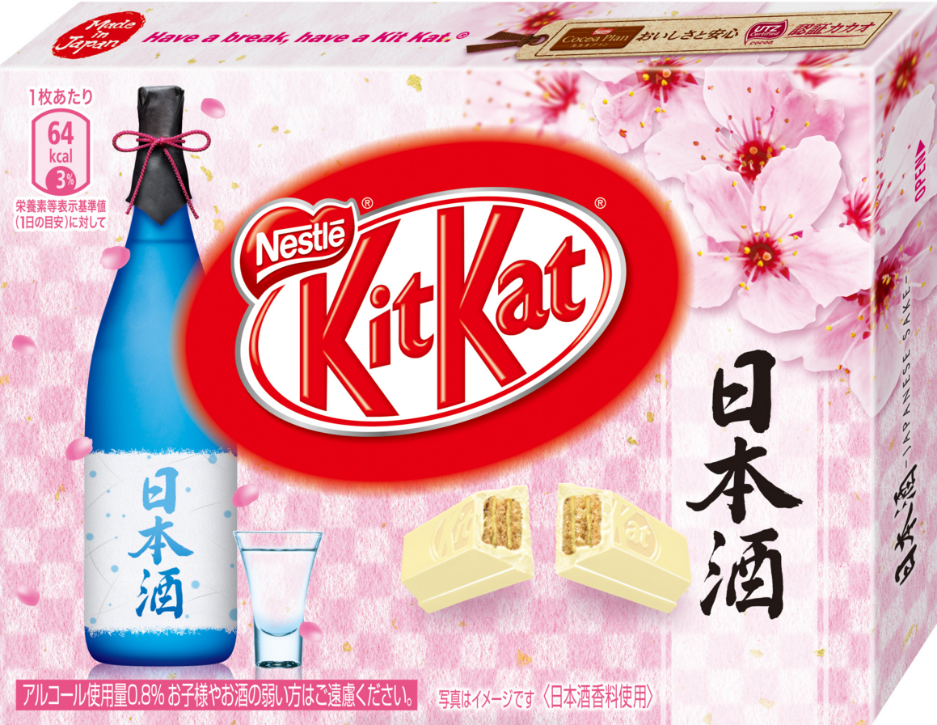For Kit-Kat lovers, Japan is a place to order from since they have so many different varieties ranging maccha green tea, strawberry cheesecake, baked sweet potato, and hazelnut. In February 2016, Nestlé Japan added a new limited time flavor to the Japanese Kit-Kat roster: Sake.
According to Nestlé Japan spokesperson Takuya Hiramatsu, sake Kit-Kat bars have an “elegant taste of sake, wrapped in the gentle sweetness of white chocolate” with “mellow, full-bodied flavor, and a refreshing aftertaste of sake.”
With the taste description, Hiramatsu points out that the Kit-Kat bars have a .08 alcohol content, so he advises against eating the chocolate with actual sake, and he advises that children and light-weight drinkers should avoid the chocolate altogether.
Sake Kit-Kat Bar are not available in the US, but can be purchased through online retailers and even eBay. Upon the release of the candy, we had an opportunity to taste-test them and provide a review.
Presentation
The Kit-Kats arrive in a cute little white and pink sakura box with a sake bottle on the cover. On the back, a “to” and “from” graphic takes up the upper left corner. The packaging looks like a Valentine’s gift, so this is a nice attention to detail. Once the candies are removed from the box, the packaging has the same sakura theme; but instead of a bottle, sake shot glasses appear on the wrapper. The presentation is definitely better than buying any old Kit-Kat bar in the United States, so it actually looks like the receiver is getting something worthwhile.
First Impression
Upon opening the foil, the scent of alcohol hits like running into a steel wall at a high speed. For people who don’t like the smell of liquor of any kind, the chocolate is a total turn-off because the scent is overwhelming and somewhat nose-burning. Within a couple of minutes, my work area smelled terribly of alcohol, almost like I went to a bar and spilled down the front of me. It’s really unpleasant and a complete departure from the adorable packaging.
The strong scent is surprising considering that the candy has a white chocolate coating. Other white chocolate Kit-Kats have a pleasant, sweet, sugary scent: Not this. This is definitely a departure from the statement Hiramatsu provided regarding the “gentle sweetness of white chocolate.” Gentle isn’t the word I would use for anything at this moment.
Taste
Before biting into the whole candy, the white chocolate coating needed to be nibbled first. Despite the smell, the chocolate has a distinct sweet, sugary white chocolate taste, but with a layer of something else that enhances the flavor. This is surprising considering how the whole treat smells overwhelmingly like a drinking party in candy form.
The whole candy tastes no different than white chocolate Kit-Kats initially. The wafer tastes like a regular Kit-Kat, making the whole moment where the candy touches the tongue a disappointment. However, the sake flavor kicks in as the candy is swallowed. When the bits reach the back of the throat, there is a slight burning sensation, and the scent of sake fills the mouth and tickles the inside of the nose. A strange warming sensation also erupts to let you know that, yes, sake is present in the candy. The slight burning sensation feels a little different than a sake, but more like something that has a hint of vodka.
The layers of flavor and how it unfolds is what makes trying sake Kit-Kat bars a different experience.
Overall
Opening the package of these Kit-Kats is an unpleasant experience unless you enjoy the smell of alcohol. The scent alone can be a turn-off, but the taste isn’t that bad until swallowed. This isn’t a candy that can be enjoyed all the time, not just because of the taste, but because of the .08 alcohol content, so don’t eat a lot. Sake Kit-Kat bars are definitely… different.
Bottom-Line: Good for the person who likes unique candy that smells like an alcohol-fueled brothel, but definitely not for everyone. They earn a score of 2/5.
—-Joelle Halon


1 Comment
I won’t be trying this after reading this. 😉